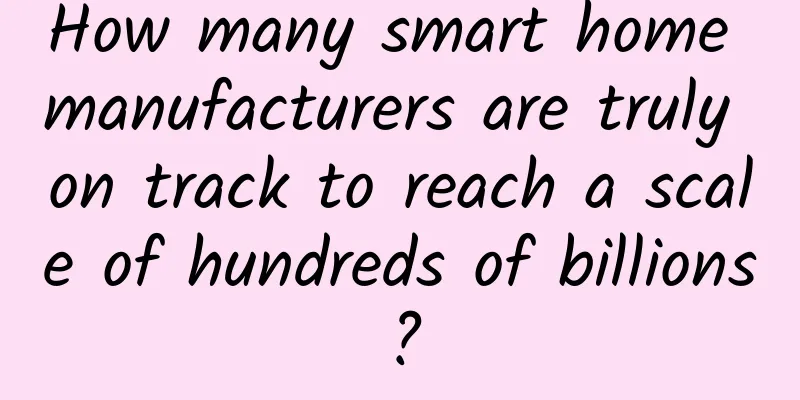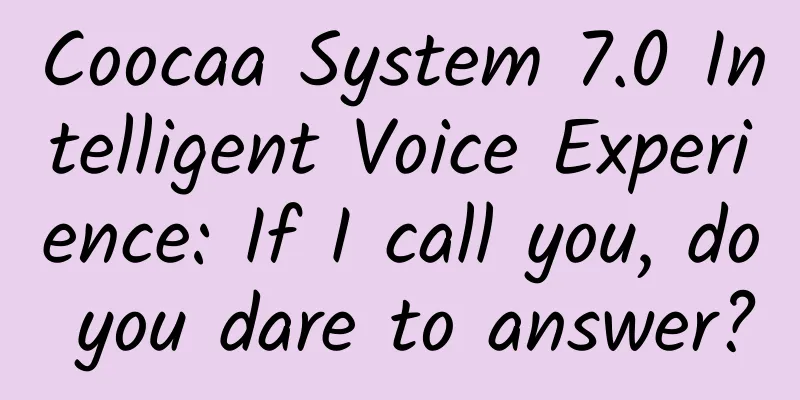How many smart home manufacturers are truly on track to reach a scale of hundreds of billions?

|
As an emerging industry, smart home is rising rapidly with irresistible momentum. Many traditional home appliance manufacturers and emerging technology companies are actively planning and staking out their territory. Despite this, it is rare to find families that actually own smart home in real life, and doubts and criticisms about it being a fake application continue to this day. Since the upsurge of intelligence was launched, all major industries have been singing the slogan of intelligence, and the home appliance industry is no exception. As an emerging industry, smart home is also rising rapidly with an irresistible momentum. According to statistics, the U.S. smart home market, which has the highest market penetration rate, only reached 5.8%, and the Chinese smart home market penetration rate was only 0.1% during the same period. It can be seen that the market penetration rate of smart home devices in the market is not high. Occupying the market and entering the market, smart homes with the Internet of Things as the core technology have broad development space in the future, but at the same time there is still a long way to go. Concept Marketing A recently released survey of smart home and smart service devices shows that the global smart home market has seen significant growth since 2010. In 2017, the global smart home market will reach $14.7 billion. After excluding large commodities such as large household appliances, the global market size of smart home devices is expected to reach $3.3 billion by the end of 2017 and $9.4 billion in 2021. In line with the market trend, major traditional home appliance retailers and emerging technology companies have continued to increase their investment in the smart home industry in recent years, trying to find the golden key to open up the market. A "horse race" to grab market share has quietly begun. In fact, the concept of smart home has set off a wave of climax in the world as early as three years ago. At the WWDC Developer Conference in 2014, Apple launched the smart home platform Homekit, which triggered the industry to follow suit. Since then, due to the lack of maturity in market application and the lack of "affordability" in price, the concept of smart home has gradually cooled down and entered a stable development period. However, as a typical application of the Internet of Things, the technology giants have not given up this huge market pie, but have launched a "secret war" in technology research and development. With the maturity of technologies such as artificial intelligence, big data, and cloud computing, the application of the Internet of Things in the home furnishing industry is now imminent, and is expected to usher in a full-scale outbreak in the next few years. Against this background, the "secret war" between the giants has also evolved into an "open war." China is naturally an indispensable player in this "land grabbing" competition. After nearly 40 years of industry ups and downs, China has long become a veritable home appliance power. However, on the road to becoming a home appliance power, intelligence is an inevitable direction. In July this year, the State Council issued the "Plan for the Development of a New Generation of Artificial Intelligence". As China's first medium- and long-term plan for the development of artificial intelligence at the national level, the document points out that by 2020, the scale of the core industry of artificial intelligence will exceed 150 billion yuan, driving the scale of related industries to exceed 1 trillion yuan; by 2025, the new generation of artificial intelligence will be widely used in intelligent manufacturing, intelligent medical care, smart cities, intelligent agriculture and other fields, and the scale of the core industry of artificial intelligence will exceed 400 billion yuan. The development of artificial intelligence will inevitably drive the rapid development of the smart home industry. Under the attractive development prospects and favorable policy environment, although China's smart home industry started late, the huge market demand has made it one of the industries with the greatest potential and fastest growth in China. According to the data of Analysys, by 2018, the scale of China's smart home will reach 180 billion yuan, which will attract a large amount of capital and enterprises to enter, and the market will see a situation of a hundred schools of thought contending. At the same time, China's smart home industry still has many shortcomings. For example, in terms of technology, there are relatively few original innovative results in core algorithms, key equipment, high-end chips, etc., and the talent pool cannot meet the rapid development needs of the smart home industry. In this regard, relevant industry insiders said that the domestic smart home market is still at the "concept" marketing stage. In fact, a true smart home is a "systematic project". It is far from enough to only make some home appliances and furniture smart. Scenario-based experience is the general trend. The battle for the entrance is full of tricks The competition for the entrance to smart home started at the beginning of the development of the smart home industry, and many smart hardwares have been anticipated. In 2014, smart routers were seen as a good entry point, and Internet companies such as Xiaomi, Baidu, 360, and Xunlei all extended their tentacles into the field of smart routers. Later, smart TVs, smart refrigerators, smart phones, smart locks, and smart cameras also joined in. This year, smart speakers have become the standard configuration of the giants' layout, and many companies have placed their bets. Behind the successive appearances of TVs, air conditioners and refrigerators, routers, and speakers, technology giants are competing to enclose land and seize the entrance to smart homes. The question that arises is, does smart home have an "entrance"? And what is this "entrance"? There is no definitive answer, and everyone has their own opinions. But what is certain is that this "entrance" can serve as the data and traffic entrance of the smart home system, and more importantly, as the "entrance" for these industries and companies to enter the home market. The router is located on the upper layer of the smart terminal and is figuratively called the "smart faucet". In most smart home systems, the smart command center, which is located in the central "brain", must be able to connect to other devices wirelessly. First of all, it must ensure that it can connect to the router and be able to connect to the Internet, which makes the router an important part of the smart home. Therefore, Internet companies such as Baidu, Xunlei, Xiaomi, and 360 are fighting for the "entrance" to the smart home market, competing to release various smart wireless routers. As the first step to surf the Internet, smart routers may play the role of network control center in the future, equipped with intelligent operating systems based on hardware configuration, thus becoming an important entrance for Internet companies to occupy the "high ground" of smart home. Take Xiaomi as an example. Through mobile phones, Xiaomi routers can form a system with Broadlink and other brands of smart home devices. Xiaomi not only wants to make Xiaomi routers a traffic entrance for smart homes, but also use Xiaomi routers as an entrance to enter smart homes. In order to develop smart homes, traditional home appliance companies such as Midea, Changhong, Gree, and TCL have naturally used smart home appliances as the physical entry point for smart homes. Their biggest advantage is the various smart home appliances such as smart air conditioners, smart refrigerators, and smart washing machines that are closer to people's lives. It is worth noting that smart homes not only require devices such as smart home appliances, but also need to use the network to connect various devices. Therefore, if home appliance companies want to transform, they must also have technologies such as the Internet of Things and cloud computing as support. To this end, in addition to smart home appliances, developing intelligent systems that connect smart home appliances and creating an open platform for smart homes may be a good choice for home appliance companies. Acquiring smart product manufacturers with a certain development foundation is the fastest way to enter the smart home market. For example, some smart home companies that already have perfect products use smart wireless gateways to connect sensors, controllers and various devices in the home to bring a good experience to users. Lin Biye, an analyst at Beijing Runzheng Investment Consulting Co., Ltd., told reporters that no matter which entrance is used, in this trillion-level blue ocean market, all major companies are rushing forward to grab a place in this market. The most intense competition in the entire smart home industry is the "entrance competition", and it is still unknown who will lead this market in the future. Break through the crux and walk steadily If we count the time when the concept of "home automation" appeared at the Chicago World's Fair in 1933, smart home is already an "old man" over 80 years old. Even if we take the world's first "smart building" built by United Technologies Corporation in 1984 as the starting point, smart home has gone through more than 30 years of growth. However, there are not many families who actually own smart homes in real life, and the doubts and criticisms about it being a fake application have not ceased. Lin Biye believes that at a time when the Internet of Things is comprehensively transforming human life, smart homes with the Internet of Things as the core technology are indeed the general trend of future development, and it is the right strategic choice for related companies to continue to make efforts. However, on the road ahead, the smart home industry needs to break through three problems in three steps before it can usher in a bright future. The first step is to integrate and unify the technical standards of the Internet of Things. At present, there are many players in the smart home market, and the interface, communication and other standards set for their independently developed products are not the same. Different brands are often difficult to connect smoothly. This behavior of setting standards is naturally to form a monopoly in the industry. However, the reality is not as people wish. Instead, it has caused serious fragmentation and hindered the progress of the entire industry. To this end, some companies have announced the formation of an IoT alliance to accelerate the process of establishing universal IoT standards through information sharing. Although the cooperation of these giants has set a good example, it is far from enough. The unification of smart home IoT standards requires the collective participation of large and small companies. The second step is to remove the control center and make intelligence truly spread to every corner of the home. Most of the smart home systems currently launched on the market have a control core, mainly a smartphone or a smart refrigerator. The ideal smart home system should be decentralized, and users can communicate directly with any home appliance in the system. These appliances are connected to each other, so no matter where the user is in the home, they can control the required equipment at any time. The third step is to upgrade the IoT security technology. Homes contain a lot of personal privacy information, so the network security issues of smart homes need to be paid special attention by the industry. As far as the current situation is concerned, there are reports that smart home products with high market acceptance, such as sweeping robots and child care robots, have been attacked by hackers and have security vulnerabilities. If network security is not guaranteed, then consumers' trust cannot be established. Even if the first two steps are taken, smart homes still cannot be implemented. Therefore, the development of security technology also needs to be prepared early. Before the price and user experience of smart homes are attractive enough, most consumers will not completely replace the entire home system for a few new smart applications. However, as time goes by and technology advances, smart homes will eventually become popular, and industry players still need to take solid steps. As a winner of Toutiao's Qingyun Plan and Baijiahao's Bai+ Plan, the 2019 Baidu Digital Author of the Year, the Baijiahao's Most Popular Author in the Technology Field, the 2019 Sogou Technology and Culture Author, and the 2021 Baijiahao Quarterly Influential Creator, he has won many awards, including the 2013 Sohu Best Industry Media Person, the 2015 China New Media Entrepreneurship Competition Beijing Third Place, the 2015 Guangmang Experience Award, the 2015 China New Media Entrepreneurship Competition Finals Third Place, and the 2018 Baidu Dynamic Annual Powerful Celebrity. |
>>: Jia Yueting suddenly spoke on Weibo: Release of new Faraday V9 model
Recommend
Microsoft CEO: If OEMs don't make Lumia phones, we'll do it ourselves
[[140618]] Since the market share has not increas...
Here are four tips to help you avoid wasting money on mobile apps!
You don’t have to build every mobile app yourself...
Bringing in 10,000 community users at 0 cost, but ultimately failing due to 12 pitfalls
WeChat officially launched mini programs at 0:00 ...
How to promote and attract traffic to Douyin? What are the 6 ways to attract fans and traffic to Douyin?
There are 6 main ways to attract customers on Dou...
Headache? Maybe you need to grow a brain!
Review expert: Yin Tielun, deputy chief physician...
How to improve conversion rate? High conversion rate tips!
"Why has the conversion rate decreased? I ca...
The leader of their migration is actually an airplane?
Right now, an incredible feat is taking place in ...
Japanese media: Volvo Cars may recruit new shareholders other than Geely
Japanese media reported that Swedish luxury car c...
Social live broadcast SOP and formula!
Brand traffic and conversion have always been ver...
How do newbies start doing SEO? How to do SEO?
Now everyone has begun to pay attention to SEO op...
The promotion of electric vehicles is the general trend and the fuel vehicle industry will eventually be eliminated
July 2, 2016: Every time technological innovation...
How to increase product repurchase rate? Share 4 tips!
Whether you are doing e-commerce or physical stor...
When I woke up, my Henan accent changed to a Northeastern accent. This disease is so socially destructive.
Recently, an overseas student blogger named "...
No need to ask the "melon photographer" for help, just look here to know whether the watermelon is sweet or not!
Midsummer has quietly arrived. The most pleasant ...
NIO APP traffic diversion strategy!
Today we disassembled the traffic strategy and re...









